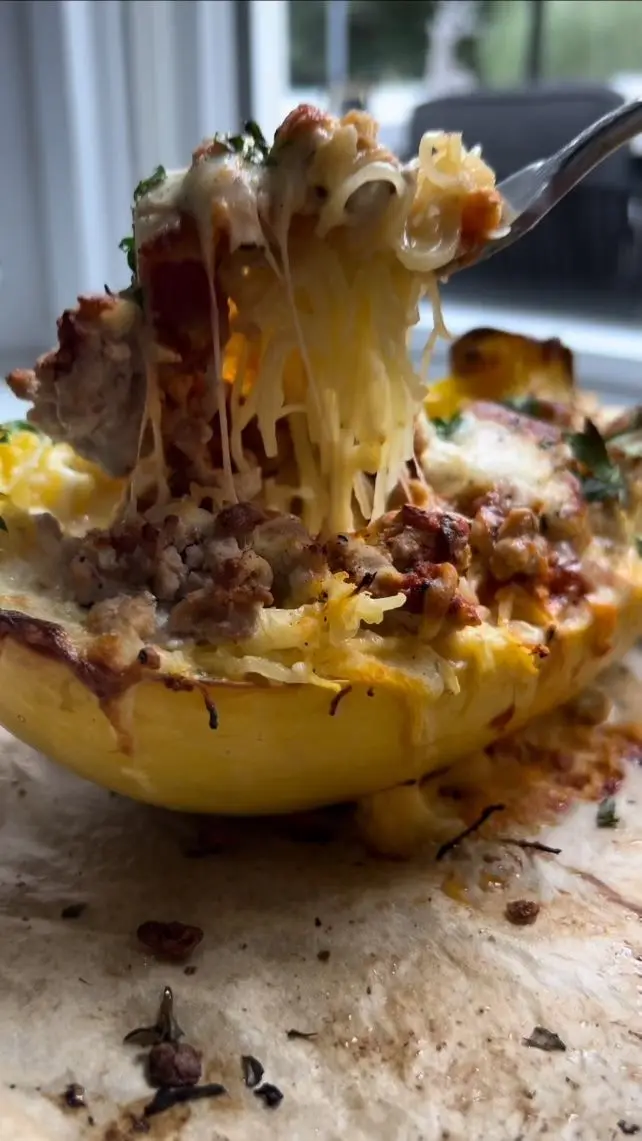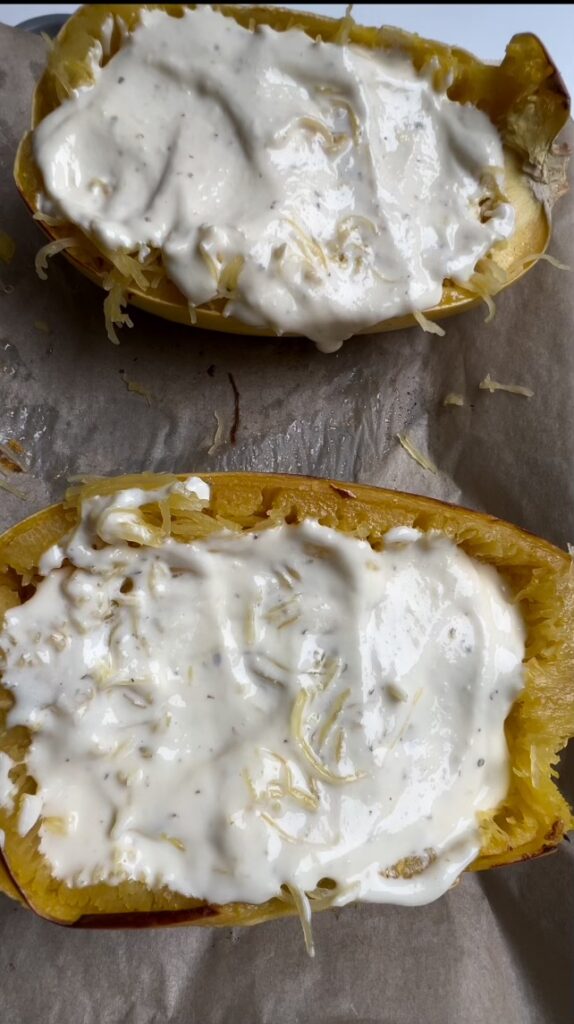How to Cook Spaghetti Squash with Creamy Sauce
There are so many reasons I love fall. The crisp weather, apple picking, fall festivals, and the seasonal produce. Squash is one of the veggies I prepare most during the fall. Acorn, butternut, and delicata, oh my!
Spaghetti squash is a favorite, too, and luckily you can often find it year-round. Not only does it have a neutral flavor that allows it to pair with just about any spices, herbs, and seasonings, but it is also a great alternative to starches.
One cup of cooked spaghetti squash provides 42 calories, 10 grams of carb, and 2 grams of fiber. This is far fewer calories and carbs than you’ll find in pasta, plus you’ll get a hearty dose of fiber. Even better, it can be the main ingredient in your entree, or a side dish.

What is Spaghetti Squash
Spaghetti squash is versatile and can be enjoyed in so many different ways as a healthy alternative to pasta, making it a favorite in many kitchens. One popular method is using an Instant Pot to cook the squash quickly and efficiently, providing tender strands that can be paired with a hearty marinara sauce, topped with fresh basil, garlic powder, and Parmesan cheese for a satisfying, low-carb meal.
Another favorite recipe is stuffing the cooked squash with a mix of sautéed vegetables, garlic, and spinach, then baking it with mozzarella or feta cheese until bubbly and golden.
For a twist, some enjoy making a creamy Alfredo-style sauce with garlic, cream, and Parmesan, mixing it with the roasted squash strands for a rich and comforting dish. These recipes are not only delicious but also nutritious, showcasing spaghetti squash’s unique texture and flavor.

How to Cook Spaghetti Squash
If this is your first time cooking spaghetti squash, don’t be intimidated. In fact, the hardest part is cutting through the thick skin. The rest of the steps are a cinch.
Cooking spaghetti squash is simple and rewarding, as it transforms into noodle-like strands that can be used in a variety of dishes.
1. Preheat the oven to 400°F and carefully slice the squash in half lengthwise using a sharp chef’s knife on a flat surface.
2. Scoop out the seeds from the inside of the squash, drizzle the flesh with a little olive oil, and season with sea salt and pepper.
3. Place the squash cut side down in a baking dish with about an inch of water, and roast for 30-40 minutes, depending on the size.
4. Once fork tender, use a fork to scrape the flesh into spaghetti squash strands, creating “spaghetti” texture.
You can also cook spaghetti squash in the microwave for a quicker option—just pierce the skin, microwave whole for 10-12 minutes, and let it cool before cutting and scraping. It’s a delicious, low-carb base for sauces, stir-fries, or even baked casseroles.

Simple Ingredients for Creamy Marinara Sauce
– Marinara sauce- Its base is made from tomatoes, which are rich in antioxidants like lycopene, known for reducing inflammation and supporting heart health. Tomatoes are also a good source of vitamins A and C, promoting immune function and healthy skin.
– Garlic and onions- These aromatics are commonly used in marinara sauce and contribute antibacterial and antiviral properties, which can support the immune system.
– Extra virgin olive oil- This oil is added for flavor and provides heart-healthy monounsaturated fats.
-Cottage cheese, parmesan, and mozzarella- These ingredients make the sauce creamy and rich once blended. They also add protein to the dish, calcium, and a variety of vitamins and minerals.
This will definitely become your new favorite recipes to make a healthy version of traditional creamy pasta sauces. The cottage cheese adds loaded of protein, allowing the meal to be more filling, and the parm and mozz add familiar, mild flavor to the dish.
Although traditional red sauce is the base of this sauce, combining it with the blended cheeses is the perfect method for adding flavor and nutrients to your meal.
If you are following a low calorie diet, you can even get part-skim or non-fat versions of the cheeses from the grocery store to lower the calorie and fat count of your sauce.
Healthy food doesn’t have to be tasteless and boring- you can pack plenty of filling, valubale nutrients into well-portioned, filling meals!

Pasta Substitutes
For those looking to cut down on carbs or try something different from traditional spaghetti noodles, there are several delicious and healthy substitutes.
Spaghetti squash is one of the most popular options, with its naturally low-calorie, low-carb profile and unique noodle-like texture when roasted. Another popular choice is zucchini noodles (or “zoodles”), which are light, fresh, and packed with vitamins and minerals.
Cauliflower gnocchi, made from cauliflower puree, offers a gluten-free and fiber-rich option that mimics the texture of regular gnocchi. Shirataki noodles, made from konjac root, are incredibly low in calories and carbs, and are often used in keto-friendly dishes.
Lentil or chickpea pasta is a protein-packed, gluten-free alternative for those looking for a more nutrient-dense swap, while still maintaining the familiar texture of pasta. Each of these substitutes allows you to enjoy your favorite sauces and toppings with a healthier twist!
How to Store your Spaghetti Squash
The absolute best way to store cooked spaghetti squash is to first allow it to cool completely after cooking. Once the roasted spaghetti squash has reached room temperature, transfer it into an airtight container to maintain its freshness and prevent it from absorbing any odors from other foods in the fridge.
Properly stored, it can last up to five days in the refrigerator, making it convenient for quick meals throughout the week. If you plan to pair it with spaghetti sauce, you can store them separately or combine them in the container, ensuring the squash maintains its texture without becoming overly soggy.
For longer storage, you can also freeze the squash in an airtight container for up to three months.
FAQs
Spaghetti squash is done when the flesh becomes tender and can easily be shredded into spaghetti-like strands with a fork. This typically takes about 30-40 minutes when roasting.
If your spaghetti squash turns out watery, it may have been overcooked or it was too hot when you started to shred it. To avoid this, be sure not to overcook it, and after cooking, allow the squash to cool slightly before shredding with a fork.
A ripe spaghetti squash should have a firm, even skin that is free from soft spots or cracks. The skin should be a uniform yellow color, and it should feel heavy for its size.

Spaghetti Squash with Creamy Sauce
Ingredients
Sauce
- 6 oz. cottage cheese
- 1/2 cup grated parmesan cheese
- 1.5 cups shredded mozzarella
- 1 egg
- 1/2 tsp dried Italian seasoning
Spaghetti Squash
- 1 large spaghetti squash
- 1 lb raw ground beef
- 4 cloves garlic minced
- 1/2 jar marinara sauce
Instructions
- Combine sauce ingredients in a blender and blend until smooth.
- In a pan, brown ground beef and minced garlic.
- Add marinara sauce to meat mixture and simmer for 10 minutes.
- Pierce spaghetti squash with knife and microwave for 5 minutes.
- Cut squash in half, and scoop out the seeds. Coat inside with olive oil, salt, and pepper.
- Bake squash face down at 375 degrees for 25-35 minutes.
- Remove squash from oven and allow to cool for 5 minutes. Now scrape inside of squash with a fork leaving the spaghetti squash inside.
- Spoon cottage cheese mixture into each half of squash, add spaghetti meat sauce next, and top with mozzarella and remaining Parmesan. Top with a little Italian seasoning.
- Place squash halves back in the oven at 400 degrees, cut side up, for 25 minutes. Enjoy!
Notes
- Carbohydrates: 12g
- Protein: 30g
- Fat: 17g
- Fiber: 2g

2 Comments